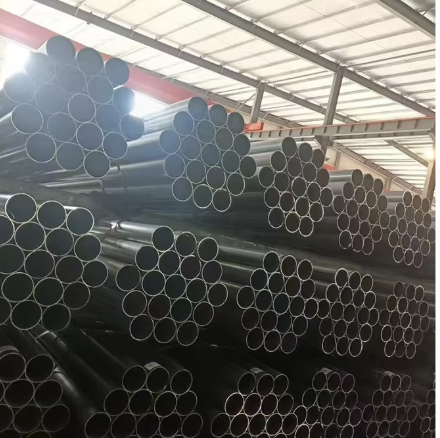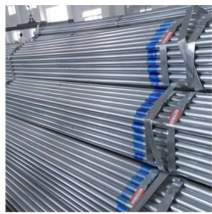Რატომ Ფოლადის მილები Კვალიტეტის შეფასება მნიშვნელოვანია
Გავლენა სტრუქტურულ მწვერვადობაზე
Ხარისხი ნიკლის ტუბები არის მნიშვნელოვანი სამშენი კონსტრუქციებისა და მანქანების მატარებლობისა და უსაფრთხოებისთვის. ეს ფოლადის მილები უკეთ მუშაობს, რათა კონსტრუქციებმა შეძლონ მძიმე წონისა და გარე წნევის გატარება, რაც უზრუნველყოფს მათ გრძელ სიცოცხლეს და სტაბილურობას. მაგალითად, ქვეყნებმა შეიძლება თავიდან აიცილონ სტრუქტურული ჩამორევები, რომლებიც ზოგჯერ იწვევს შენობების დანგრევას, როგორც ზოგიერთ ტრაგიკულ შემთხვევაში, სადაც დაბალი ხარისხის ფოლადი გამოიყენეს მშენებლობისას. 1968 წელს რონან პოინტის საცხოვრებელი კორპუსის დანგრევა დრამატული შეგახსენებელი იყო იმის შესახებ, თუ რა შეიძლება მოხდეს, როდესაც სტრუქტურული მთლიანობა საკითხშია – ერთი გაზის აფეთქება გამოწვეული ჰქონდა 22-სართულიანი შენობის პროგრესულ დანგრევას, რაც მომდევნო სიკვდილებსა და დაჭიმულობებს გამოიწვია. ასეთი ჩამორევები გვახსენებს, რომ უნდა დავიცვათ მკაცრი კრიტერიუმები, როგორიცაა ASTM, ISO, რომლებიც განსაზღვრავენ ფოლადის მილების ხარისხსა და მუშაობის მაჩვენებლებს.
Ინდუსტრიული სტანდარტები ASTM-ის (ამერიკული სოციეტეტი ტესტინგთა და მატერიალებთან) და ISO-ს (საერთაშორისო .Organization სტანდარტიზაციისთვის) ძალიან მნიშვნელოვანი როლი ასრულებენ პროდუქციის ხარისხის გარანტირებაში და სიმართლე და სიმართლივობის მართვაში ფერონი გამოყენებული შენობაში, ავტომობილებში, ჰაერონავტიკაში და სხვა აპლიკაციებში. სტანდარტებში მითითებულია ფერონის ტუბების გარემო, რომლებიც გამოიყენება შენობაში. ეს სტანდარტების დარღვევით, კომპანიები შეძლებენ შემცირებას სტრუქტურული ჩართვის რისკებისა და უფრო უსაფრთხო გარემოს შექმნაში. ასე რომ, ფერონის ტუბების სიმართლე არ არის მხოლოდ ფორმალიზმი, ეს ძალიან მნიშვნელოვანია ჯაროს უსაფრთხოებისა და სტრუქტურის მัნამდინარეობისთვის, და სამაგრამო მოთხოვნები არსებობს სტრუქტურულ ინჟინრინგში და ინჟინრინგის სტანდარტებში, განსაკუთრებით მაღალი რისკის შენობებში, როგორიცაა სკი სკრაპერები და მостები.
Დარგის სპეციფიკური უსაფრთხოების მოთხოვნები
Განსხვავებული ინდუსტრიებში მოთხობაა სპეციფიკაციების მითითება სიყვარულის გამოყენებისთვის, სანამ სტანდარტები საკმარისად მაღალია, ამიტომ კითხვა გარკვეული ხარისხის შემოწმების მიმართულია. საბეზრის წესების მითითება არის ძველი სექტორებისთვის, როგორიცაა საშენო, ავტომობილების ან ჰაეროსფერი ინდუსტრია. მაგალითად, საშენო ინდუსტრიაში, Blevins-ის სიტყვებით, მეტალურგიული ტუბები გამოიყენება საჭიროებში, როგორიცაა საფეხვრი და კონკრეტის განაკვეთის დამატება, და მასალების გამოყენება, რომლებიც არ არის შემოწმებული, შეიძლება გამოწვევის მიზეზი გახდეს. განსხვავებული ავიაციული სექტორი, სადაც ზუსტობისა და საბეზრის მოთხობა საკმარისად მაღალია, საუკეთესო ხარისხის მეტალურგიული ტუბები არ მხოლოდ უზრუნველყოფენ ჰაეროსფერი მანქანებისა და მათი კომპონენტების მექანიკური მოთხობების შესრულებას, არამედ დახმარება ასევე ხელს ხარჯად მიყვანის ავარიას.
Მნიშვნელოვანი გარდაქმნები, :both legal and financial, შეძლობენ თუ არ მიჰყვებით ამ საფეხურო სტანდარტებს. წევრების უკანასკვერობა განსაზღვრავს შემდგომ სამართლებრივ პროცედურებს, არა მოითხრებით ფინანსური პასუხისმგებლობები, რომლებსაც ჩაერთვება სამართლებრივი საკონტრაქტო გადახდები, კომპენსაცია და რეპუტაციის დაზიანება. ანალიზის მიხედვით U.S. Occupational Safety and Health Administration (OSHA)-ს, საფეხურო წესების უკანასკვერობა განსაზღვრავს ათასამდე შემთხვევას და მრავალმილიარდოვან წლიურ პასუხისმგებლობის მოთხოვნებს. ამ მონაცემები განსაზღვრავს ჭირვებას მოწყობილობის შესაფასებლად და დამატებითი დეფექტების განსაზღვრისა და მართვისთვის სირკონის ტუბებში საფეხურო საშიშის წარმოების წინააღმდეგ. ბოლოს, ეს მეთოდები დაცულია ინდუსტრიების შესაფასებლად და ყველა სირკონის ტუბების გამოყენება დადგენილია უსაფრთხოდ და მั่ნად.
Მასალის კომპოზიციის ანალიზი სტირლინგის ტუბებისთვის
Არსებითი როლი კარბონისა და ალიურის შინაარსი
Სიდირი ტუბების შემთხვევაში, მნიშვნელოვანია განიხილოთ კარბონის და ალიურის მი Gaussian-ის მიცემულები მექანიკური თვისებების განსაზღვრისას. განსაზღვრავი ძალა, გამჭვრელობა, მოწყალობა და სხვა ფაქტორები გავლენას ახდენენ კარბონის განსხვავებულ დონეებზე და განსხვავებულ ალიურ ელემენტებზე, როგორიცაა ქრომი, ნიკელი და მანგანი. ეს ჩვეულებრივ ამაღლებს მოწყალობას და ძალას, მაგრამ შეიძლება გადახრიოს ბალანსი ძალასა და გამჭვრელობას შორის. სხვა მხარეს, დაბალ კარბონის შემთხვევაში, ნაკლებად ხარისხიანია, სტალის მეტი განვითარების მოთხოვნა. ამ ბალანსის მნიშვნელობაა სიდირი ტუბის წარმატებისთვის რაოდენობის გამოყენებაში. როგორიცაა საშენო პროექტები, ალიურის განსაზღვრის სპეციალური კრიტერიუმის შემთხვევაში, აუცილებელია ამ ორის მიერ განსაზღვრული გამოკლების შესაბამისად ძალასა და განვითარების მოთხოვნასთან ერთად, და მაგრამ მუდმივობისა და უსაფრთხოებისთვის.
Კედლის თანმიმდევრული სისქის ტესტირება
Სტილის ღრუბლების სიგანეზე შესრულებული კვალიტეტის კონტროლი ძალიან მნიშვნელოვანია პერფორმანსის და მართვის მხარდაჭერის მaintaining-ისთვის, განსაკუთრებით დინამიკური აპლიკაციების შემთხვევაში. მეთოდები, როგორიცაა ლაზრის სკანირება და ულტრასაouncქვე ტესტირება, ხშირად გამოიყენება სიგანის ზუსტი ზომის გასარჩევად. სტანდარტული ტოლერანსები გაკეთებულია საბრძოლო მიზნით და უნდა იყოს ნორმა, რომ არ იყოს 잠 pontential სტრუქტურული საშუალება. ღრუბლის არაერთობრივი სიგანე შეიძლება გამოწვევის წერტილების გამოწვევას განსაზღვროს, რაც შეიძლება დაზღვევის მთავარ სტრუქტურას დაარღვიოს, რაც შეიძლება იყოს პრობლემა, მაგალითად, საწვავო სისტემებში ან მძიმე მაशინებში, სადაც სტრესი უნდა გავრცელდეს ერთნაირად.
Ქიმიური საშუალების დადასტურების მეთოდები
Სიდის ტუბების ქიმიური საშუალო უნდა გაიკრითიკოს, რათა დარწმუნდეს მათი მთავრობა და ფუნქციონირება. სტანდარტული მეთოდი behemesthesia @2345ring ტექნიკების, როგორიც არის სპექტროსკოპია და X-რაის ფლუორესცენცია, ხშირად გამოიყენება სიდის შესაბამისობის დადგენისთვის ამ სპეციფიკაციებს. ეს განსხვავება ძალიან დიდ გავლენას ახდენს სიდის თვისებებზე, ჩა Gaussian დაბრუნებული მუშაობა ან სიდის პროდუქტის ვერ წარმატებული გამოყენება მის შუალედურ გამოყენებაში. სტანდარტული აუდიტები და კომპლიანსის შემოწმებები ძველი არიან მასალის კონტროლის მართვაში და დარწმუნებით, რომ არ არის გადახრა მითითებული ქიმიური საშუალოდან, რაც განსაზღვრავს აუცილებლობას ხელნაწყავი მოსამართლების ქიმიური ვერიფიკაციის პროცესებში.
Მექანიკური თვისებები და გამძლევადობის ფაქტორები
Განვრცხვის ძალის ტესტირების პროტოკოლები
Რამდენად ძლიერი შეიძლება სურგანის ტუბები წამახვილობისგან დაცული იყოს? განჭერის ძალის ტესტი აღწერს მთელ ისტორიას. სანამუშირო მეთოდში წარმოება მიიღება ეს ზედსართავი პრეტრეიტმენტის გამო, რაც უზრუნველყოფს წარმოქმნილ ნამუშირების ჰომოგენური მასალის წარმოებას. ლაბორატორიებში ჩვეულებრივ გამოიყენება უნივერსალური ტესტირების მაशინი, რომელიც წარმოქმნილ ნამუშირებზე დაარსებს ერთმანეთს მიერთივ ჩამორთვას, სანამ ისინი არ წაიჭრებიან. განჭერის თვისებების ტესტი გვეუბნება, რამდენად შესაბამისია სურგანის ტუბები მაღალი სტრესის გარემოში, მაგალითად, სამშენებლო სფეროში ან მძიმე მანქანებში, სადაც საჭიროა სწორი მოწყობა და მასალის წარმოღება უნდა იყოს უარყოფილი. ინდუსტრიის ექსპერტები აcentრებენ მეთოდობის მნიშვნელობას ასეთი ტესტების შესრულებისას, რათა უზრუნველყოფოს ერთსამანეთობა და განმეორება, და ჩვეულებრივ რекომენდებენ მიმდევრობის მსგავს რეკომენდაციების მსგავსი ASTM E8/E8M სტანდარტის მიმოსახერხებლად უკეთესი შედეგების მისაღებად.
Flexibility and Fatigue Resistance Evaluation
Განვითარების და უკეთესობის მწვრთნელობა არის მნიშვნელოვანი თვისებები, როდესაც ფერო ტუბები განხილულია ციკლური ჩატარების ქვეშ, როგორც ხიდების ან მაशინების შემთხვევაში. ამ თვისებების შეფასება ზოგადად ნიშნავს ტესტების ჩატარებას, როგორიცაა დინამიური გაღების ტესტები და უკეთესობის ძალის ტესტები, რათა ნახოთ, როგორ მართავтся ტუბები განმეორებადი ჩატარების ციკლების ქვეშ. ეს ტესტები არის საჭირო პროდუქტის ციკლური ანალიზისთვის, რათა შესაძლოა ინჟინერებს მัრთავიანი წინასწარ გამოვიყენონ ფერო კომპონენტების სერვისის ცხოვრება. პრაქტიკული გამოყენება გამოსახავს ამ თვისებების მნიშვნელობას, მაგალითად, ავიაციულ კომპონენტის შემთხვევაში, რომელიც განვითარდა აქ, მასალების კამპუსში შემთხვევითი უკეთესობის ვარავლებები შეიძლება გამოიწვიონ კატასტროფული ვარავლებები და საჭიროა დარწმუნებული იყოს, რომ ფერო ტუბები მiliki მიმართული უკეთესობის უკეთ წინააღმდეგობა, მართვა განვითარების შენარჩუნებით.
Კოროზიის უკეთესობის სტანდარტები
Კოროზიულ დაღმასავალი ძალიან Gaussian განვითარებულია ხარშებრივი გარემოში სპეციფიკაციის გარდა, ASTM G85-ის მსგავსი სტანდარტები დაყოვნებულია განსხვავებული კოროზიული დაღმასავალის ტესტირების კრიტერიების დაყოვნებაში, რომლებიც შეიძლება განხორციელდეს სპიროს პროდუქტებზე. ტესტირების მეთოდები შეიძლება მრავალფეროვანი იყოს, ჩათვლილი აქსელერირებული სიმულაციები ლაბორატორიაში და გამოხატვის ტესტები გარემოს პირობებში. ეს შედის სალი სპრეი ტესტებიდან, რომლებიც სწრაფად შეამოწმებს კოროზიულ გამოწვევის შესაძლებლობას, მდგრად გარემოში გამოხატვამდე, რომელიც სიმულირებს გრძელი გარემოს გავლენას. კოროზიულ დაღმასავალი სპიროს დასახირების საშუალებების მიღება ძალიან დიდია — ის შენახავს მართვის ხარჯებს და განახლებულია პროდუქტების ცხოვრება, რაც მნიშვნელოვანია გრძელი ინფრასტრუქტურის პროექტებისთვის.
Ფოლადის მილების მთლიანობის საჭირო ტესტები
Დანარგვალი ტესტი: გამრუდება და გადაჭრის ანალიზი
Დაზიანებული ტესტირება მნიშვნელოვანია სპრეცის ტუბების მასალების ზღვარის ანალიზისთვის მიმატების ქვეშ, სანამ წარმატებული ვარაკი მიღებული იქნება. ეს ტესტირება საჭიროა მასალების მუშაობის თვისებების გასაგებად. გახრევის ტესტები და გადახრის ტესტები არის ორი ყველაზე გავრცელებული დაზიანებული ტესტი. გახრევის გარეშე ძალა და გამძლევა განსაზღვრებულია სპრეცის ტუბის გახრევით პირველ დეფორმაციის წერტილამდე. გადახრის ტესტები უბრალოდ განსაზღვრავენ მძლოვარებას და უახლოეს გადარჩენის წინააღმდეგობას. ეს ტესტირებები უნდა განხორციელდეს ხარისხის შეფასებისთვის, რადგან ისინი გამოხატავენ პროდუქტებში მყარ დეფექტებს და ზოგადად არ არის გამოჩნდებული არა-დაზიანებულ ტესტირების მეთოდებში. მაგალითად, დაზიანებული ტესტირება გამოაკვეთილა წინადადებები წარმოების პროცესში გამოყენებული წარმოადგენილი მასალების არჩევაში, და განხორციელდა გარდაქმნები წარმოების პროცესში პოტენციური ვარაკების გამოსაცდელად.
Არა-დაზიანებული მეთოდები (ულტრასაouncე, X-Ray)
Ფორმატის შეცვლა გარეშე შემოწმების (NDT) ტექნიკები, როგორიცაა ულტრაბგერითი შემოწმება და X-გამოსხივებითი შემოწმება და სხვა, მნიშვნელოვან როლს ასრულებს ფოლადის მილების მთლიანობის შეფასებაში განადგურების გარეშე. ულტრაბგერითი შემოწმება გულისხმობს მილში მაღალი სიხშირის ბგერითი ტალღების გატარებას და გამოიყენება კედლის სისქის გასაზომად და შიდა ნაკლოვანებების, როგორიცაა კოროზია, ასაჩანად. X-გამოსხივებითი შემოწმება კი, პირიქით, იწვევს გამოსხივებით გამოწვურულ გამოცემას და უფრო ხელსაყრელია შიდა სტრუქტურული პრობლემების ასაჩანად, რათა დამალული პრობლემები გადაიჭრას. ეს ყველაფერი იძლევა იაფ და უსაფრთხო არჩევანს იმ პროდუქტების შესამოწმებლად, რომლების დაზიანებასაც ვერ გვინდა. მანქანაშენებისა და ავიაციის მრეწველობებში NDT განსაკუთრებით მნიშვნელოვანია იმ აქტივების მუდმივი მომსახურების უზრუნველსაყოფად, სამუშაო პროცედურების სწრაფად გასატარებლად პრობლემის აღმოჩენის შემთხვევაში და აქტივებისა და ადამიანების უსაფრთხოების უზრუნველსაყოფად.
Ⴧიდროსტატური წნევის ტესტირება
Ჰიდროსტატური წნევის ტესტი არის მნიშვნელოვანი პროცესი, რომელიც დამტკიცებს სიმართლე სიყვარული ტუბებისთვის ახალი ან ღირებული გაზის ან ღელის მოქმედებისთვის. ეს ტესტი შედგება ტუბის შევსებით წყალით ან სხვა ღელთან და წნევის გამოცდილებით, რათა ნახოს, შეძლებს თუ არა მას მაღალი წნევები გამართული იქნებინაირად გაუმართოს. მნიშვნელოვანად, პროცესი გამოიყენება საფრთხეების გამოსაცნობად, რომლებიც შეიძლება მიიყვანონ ტუბის მუშაობის დროს ხარვეზე. წნევის ლიმიტები: მიღებული ლიმიტები, რომლებიც შედგება ეს ტესტების სკოპის მიხედვით, ჩამოყალიბდება მასალის ტიპებზე და ტუბების მიზნებზე. ჰიდროსტატური ტესტირება მრავალ ინდუსტრიაში არის მიუთითებელი როგორც დამტკიცების მოთხოვნა, და რომ დადასტურებს, რომ ჰიდროსტატური წნევა უსაფრთხოდ შეიძლება მართვა.
Პოზიტიური მასალის იდენტიფიცირების (PMI) ტექნიკა
PMI (პოზიტიური მასალების იდენტიფიკაცია) არის ნებისმიერი დახრივი ტესტირების პროცესი, რომელიც განსაზღვრავს სასტილო ტუბების მასალის კლასს და საშუალებას. PMI მეთოდები, როგორიცაა X-რაის ფლუორესცენცია (XRF) და ოპტიკური ემისიული სპექტროსკოპია, არ არის საშუალებაში ზუსტად იდენტიფიცირებინა მასალების საშუალება. XRF ზომავს ელემენტების მიერ წარმოქმნილ ფლუორესცენტურ ქსელს, ხოლო ოპტიკური ემისიული სპექტროსკოპია გამოიყენება სანამუშირ სინათლის შემოწმებისთვის, როდესაც სანამუშირი გადარჩენილია სპარკის ან გათბობის შემდეგ. ეს ტექნიკები არის უმეტესად აუცილებელი მასალების შეცვლის იდენტიფიკაციის შეცდომების შემცირებისას, რაც შეიძლება გამოწვეული იყოს კატასტროფიული ვაჭრობა. ინდუსტრიულ შემთხვევების შემთხვევები მრავალჯერ აჩვენებს, რომ PMI-მ არის შესაძლო მიზნის შესახებ, რაც განსაზღვრავს მუშაობის სრული წარმატებას ან წარმატების გარეშე.

Ზღვარის ხარისხის და კოროზიის წინააღმდეგ მდგომარეობის შეფასება
Ზღვარის გარკვეულობის და დაფიქსირების შემოწმება
Ზედაპირის ხარისხი მნიშვნელოვან როლს თამაშობს უკეთხველი ფოლადის მილების შემთხვევაში, განსაკუთრებით იმ მილების შემთხვევაში, რომლებიც სითხის ტრანსპორტირებისა და ზუსტი გამოყენების მიზნით გამოიყენება. გლუვი ზედაპირი ასევე მნიშვნელოვნად ამცირებს მილის გახმარებას, რაც მისი სამსახურის ვადის გასაგრძელებელია. საფარი მნიშვნელოვან გავლენას ახდენს ზედაპირის ხარისხის გაუმჯობესებაზე და გაძლევა გაუმჯობესებული ანტიკოროზიული თვისებების მიცემა. საფარი ჩვეულებრივ ცინკდებული ან ეპოქსიდური საფარით არის დაფარული, რომელიც გარემოსგან უზრუნველყოფს სპეციფიკურ დაცვას. ზედაპირის ხარისხის შემოწმება ზედაპირის ხარისხის შემოწმების მეთოდები მოიცავს ვიზუალურ შემოწმებას, მიკროსკოპულ გამოკვლევას და შესაბამისობას დამტკიცებულ სტანდარტებთან (ISO, ASTM) ინდუსტრიული ეტალონებთან შესაბამისობის დასადგენად დეფექტების გასამოსავლენად.
Სალის სპრეის ტესტი რუსტის პრევენციაში
Სალის გამრუდების ტესტირება არის განსაკუთრებით მნიშვნელოვანი ეტაპი სიმღერის წინააღმდეგობის შეფასებისათვის სპეციალურ სახელმძღვანელო ტუბებში. ტესტირება მასალას ქვეშ ადგილებს სალის წყალის მცირე მწვანე მისით, რომელიც მწარმოებლებს ხელს უწყობს წინააღმდეგობის ელემენტების მოქმედების განმავლობაში როგორც გამოჩნდება ტუბი. ნორმები (მსგავსი ASTM B117) აღწერს ტესტირების მეთოდების შესრულებას და შესაბამისად შაბლონის ინტერპრეტაციას. მწარმოებლებისთვის, ამ მოთხოვნების მისამართებლად ძალიან მნიშვნელოვანია ბაზარის დასატოვებლად და მათ პროდუქტების მართვის უზრუნველყოფა. მინიმალური დროები წარმატებისამდე (ან მსგავსი დაფარვის ეფექტიურობამდე), როგორც მოითხოვს ინდუსტრია, შეიძლება გამოვიყენოთ როგორც ბაზის წერტილები, როდესაც მწარმოებლები სცადებენ გაუმჯობესონ მწარმოებლობის პროცესები მაღალი სტანდარტების შესაბამისად.
Გარეგნული გაწვრივების შეფასება
Გარემოს წნევითი დატრიალების შემთხვევა, გარკვეული ქიმიური აგენტებისა და ტემპერატურის ციკლების გამოყენებით, არის ძირითადი პრობლემა სისტემებში გამოყენებული საფულეებისთვის, რომლებიც მუშაობენ გარკვეული მძიმე პირობებში. ამის გაკეთებლად არსებულია ტესტები, როგორიცაა აჩქარებული ვარჯიშის ტესტები, სადაც მასალები აღწერილია კონტროლირებულ გარემოში, რათა წარმოადგინოს მათი ცხოვრება და ძალი. სტანდარტებზე მისაღება, როგორიცაა ASTM D543, აძლევს სრულყოფას მასალების შეფასებასა და განვითარებას, რომლებიც არიან დატრიალების წინააღმდეგ. სტატისტიკა აჩვენებს, რომ ცუდი შეფასებები შეიძლება გამოიწვიონ ხარჯად სისტემების ვარავლებას, ამიტომ ეს არის მნიშვნელოვანი საკითხი. მაგალითად, შესაბამისი წნევითი დატრიალების ტესტის გამოყენების გარეშე შეიძლება გამოიწვიოს წინააღმდეგ სტრუქტურების გამოსვლები ან დატრიალება, რაც მიუთითებს შესაბამისი ტესტირების მეთოდების მნიშვნელობაზე.
Ხელიკრული
Რატომ არის საგრძნო სიდის ტუბის ხარისხის შეფასება?
Რკინაული ტუბის ხარისხის შეფასება ძვირად არის მნიშვნელოვანი შესაბამისი სტრუქტურის მთავრობის, უსაფრთხოების და გამყავის დაზღვევისთვის შენობებში და ინფრასტრუქტურაში. ის პრევენციურად აწყობს ვადაკებებს, შესაბამისი ინდუსტრიული სტანდარტების ჩათვლით.
Რა არის ინდუსტრიული სტანდარტები რკინაული ტუბებისთვის?
Ორგანიზაციები როგორც ASTM და ISO განათავაზენ სტანდარტები, რომლებიც მითითებენ საჭირო მახასიათებლებს რკინაული ტუბებისთვის, დარწმუნებით, რომ ისინი შეესაბამებიან უსაფრთხოებისა და მართვის სტანდარტებს განსხვავებულ გამოყენებებში.
Როგორ ვერიფიცირება რკინაული ტუბების ქიმიური სამყარო?
Ქიმიური სამყარო ვერიფიცირება ხდება ტექნიკების გამოყენებით, როგორიცაა სპექტროსკოპია და X-რაის ფლუორესცენცია, რათა დარწმუნდეს, რომ რკინაული შეესაბამება მითითებულ სპეციფიკაციებს, უზრუნველყოფს მუშაობას და პრევენციურად აწყობს ვადაკებებს.
Რა არის არაგარდაქმნიანი ტესტირების მეთოდები რკინაული ტუბებისთვის?
Არაგარდაქმნიანი ტესტირების მეთოდები, როგორიცაა ულტრასაუნდისა და X-რაის ტესტირება, შეფასებს რკინაული ტუბის მთავრობას გარდაქმნის გარეშე, უსაფრთხოებისა და ეფექტიურობის გამარტივებით ინდუსტრიებში, როგორიცაა ჰაეროსფერი და ავტომობილები.

